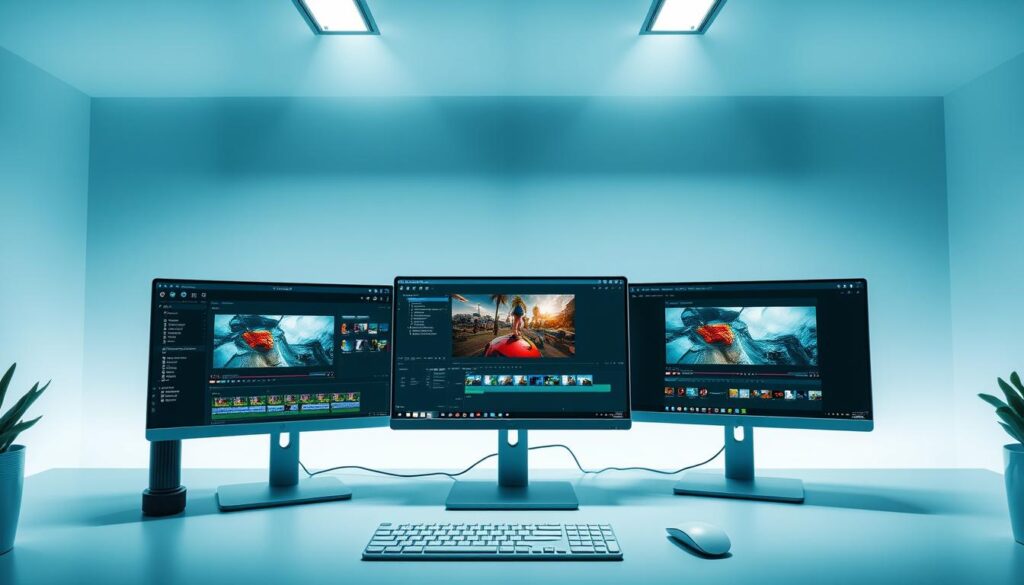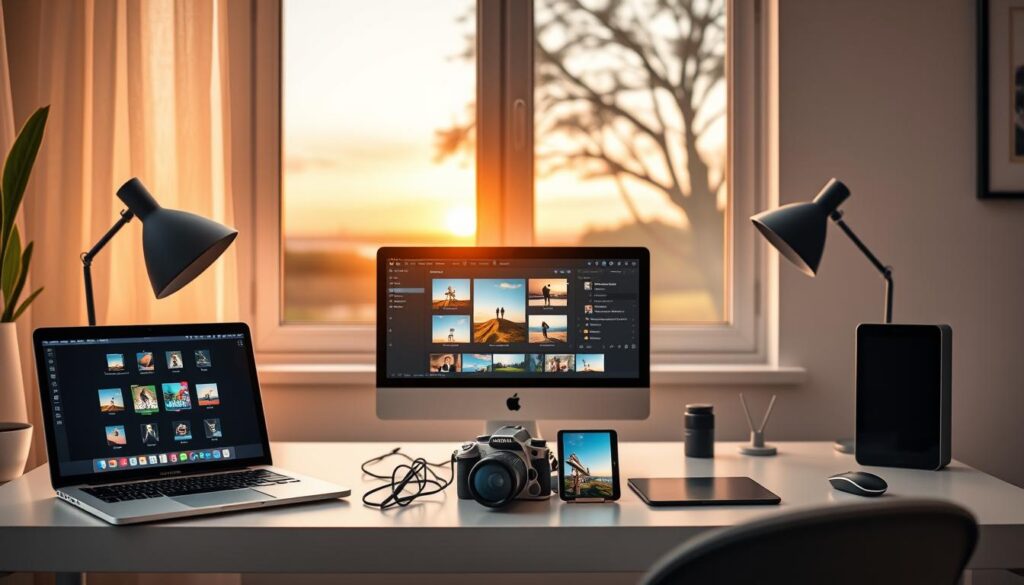Did you know the global video editing software market is set to hit $2.4 billion by 2025? With digital content on the rise, picking the right tool is more important than ever.
Finding the best editing software can feel overwhelming with so many choices. Knowing what you need and want is crucial. This guide will help you understand what to look for in editing tools. You’ll learn how to pick the one that fits your work style and boosts your productivity.
Key Takeaways
- Understand your specific needs before choosing an editing tool.
- Compare key features of different editing software.
- Consider your workflow and productivity when making a decision.
- Read reviews and ask for recommendations.
- Test the software before committing to a purchase.
What to Look for in Editing Software
Finding the right editing software starts with knowing what features, interface, and compatibility you need. It’s important to pick what makes editing easier and faster for you.
Features You Can’t Ignore
Some editing software features are must-haves. Multi-track editing lets you work with many video and audio tracks at once. This makes your projects more flexible.
Color correction is also key. It helps improve your project’s look by adjusting brightness, contrast, and color.
Audio ducking boosts your project’s sound quality. It automatically lowers background music or audio when dialogue or narration is spoken. Experts say the right features can greatly improve your final product.
User Interface Considerations
The software’s user interface is crucial for a good editing experience. A user-friendly interface saves time and reduces stress. Look for software that lets you customize your interface to fit your workflow.
- A clean and organized layout
- Easy access to primary editing tools
- The ability to customize the interface to your preferences
Compatibility with Your Devices
Make sure your editing software works with your devices for a smooth workflow. Check if it’s compatible with your operating system, like Windows, macOS, or Linux. Also, see if it supports external devices like cameras, microphones, or hard drives.
“Compatibility is key to a hassle-free editing experience. Ensure your software and hardware are on the same page.”
Top Editing Software Comparisons
There are many video editing software options out there. It’s important to compare the top ones to find the best for your needs. We’ll look at some leading video editing software, highlighting their good and bad points to help you decide.
Adobe Premiere Pro vs. Final Cut Pro
Adobe Premiere Pro and Final Cut Pro are two top choices for video editing. Premiere Pro works on both Windows and macOS, making it great for editors who switch between platforms. Final Cut Pro, however, is only for macOS and is known for its high performance and advanced features for pros.
| Feature | Adobe Premiere Pro | Final Cut Pro |
|---|---|---|
| Operating System | Windows, macOS | macOS |
| Multi-Cam Editing | Yes | Yes |
| Color Grading Tools | Advanced | Advanced |
| Audio Editing | Basic | Advanced |
Choosing between Adobe Premiere Pro and Final Cut Pro depends on your needs. If you use both Windows and macOS or are part of the Adobe ecosystem, Premiere Pro might be better. But if you’re on macOS and want top-notch editing, Final Cut Pro is worth a look.

DaVinci Resolve vs. Filmora
DaVinci Resolve and Filmora serve different markets. Resolve is for pros, offering advanced color and audio tools. Filmora is easier to use, perfect for beginners and hobbyists, with all the basics without the complexity.
| Feature | DaVinci Resolve | Filmora |
|---|---|---|
| Learning Curve | Steep | Easy |
| Color Grading | Advanced | Basic |
| Audio Editing | Advanced | Basic |
| Export Options | Varied | Varied |
If you’re a pro needing advanced tools, DaVinci Resolve is a great pick. But if you’re new or want something simple, Filmora is a better fit.
Camtasia vs. iMovie
Camtasia and iMovie are great for different needs. Camtasia is known for its screen recording and is used for tutorials and presentations. iMovie, free on macOS, is perfect for beginners.
| Feature | Camtasia | iMovie |
|---|---|---|
| Screen Recording | Yes | No |
| Cost | Paid | Free |
| User Interface | User-friendly | User-friendly |
| Advanced Features | Yes | No |
Camtasia is best for those needing advanced screen recording and editing. iMovie is free and easy to use, great for personal video editing.
Pricing Structures of Editing Software
Understanding the pricing of editing software is key to making a good choice. The cost is a big factor in picking the right tool for your needs.
There are mainly two pricing models: subscription-based services and one-time purchases. Knowing the difference between these is important for finding the best fit for your budget and editing needs.
Subscription Models vs. One-Time Purchases
Subscription models, like Adobe Premiere Pro, need you to pay a recurring fee, often monthly or yearly. This gives you access to updates, new features, and support. On the other hand, one-time purchases, like some Filmora versions, cost a single payment for lifetime use, but updates might cost extra.
Think about your budget, how often you use the software, and if you need the latest features. Professionals might choose subscriptions for the latest tech, while hobbyists might save money with one-time purchases.
Free Trials and Freemium Options
Many providers offer free trials or freemium models to let you try before buying. Free trials give you a short time to check out the software’s features. Freemium models offer basic features for free but charge for more advanced ones.
Using these options can help you see if the software fits your needs and is worth the cost. For example, DaVinci Resolve has a free version with great features, making it a good choice for those on a budget or with simple editing needs.
By looking at pricing and trying software through free trials or freemium models, you can make a smart choice that fits your editing goals and budget.
Beginner-Friendly Editing Software
Starting with video editing? It’s key to pick software that’s both strong and simple. The right tool can greatly affect how fast you learn and enjoy editing.
For new editors, the main thing is to find software with easy-to-use features. Intuitive interfaces and helpful tutorials are vital for quick learning.
Key Features for Novice Editors
Beginner-friendly editing software should have features that make editing easy. Look for:
- Drag-and-Drop Functionality: Makes importing and arranging media simple.
- Pre-Made Templates: Provides a starting point for common video types.
- Real-Time Preview: Lets you see your edits as you make them.
- Automated Editing Options: Some software can create a rough cut for you.
Here’s a look at some popular beginner-friendly editing software:
| Software | User Interface | Tutorials Available | Price |
|---|---|---|---|
| iMovie | Very User-Friendly | Yes | Free |
| Adobe Premiere Elements | User-Friendly | Yes | $99.99 |
| DaVinci Resolve | Moderately Complex | Yes | Free/Paid |

Learning Resources and Support
Features aside, learning resources and support are crucial. Look for software with lots of tutorials, active forums, and good customer support.
Many editing software solutions have lots of tutorials and guides. YouTube channels and online courses on video editing are also great resources.
Advanced Editing Features for Professionals
To improve your editing skills, you need software with advanced features. These features are key for creating top-notch content. In today’s competitive media world, your work must stand out.
Having the right tools is crucial for professional editing. Look for software with multi-cam editing capabilities and advanced color grading and special effects.
Multi-Cam Editing Capabilities
Multi-cam editing lets you switch between camera angles smoothly. This makes your videos more dynamic and engaging. It’s great for live performances, interviews, or scenes shot from different angles.
Adobe Premiere Pro and Final Cut Pro are top choices for multi-cam editing. They make it easy to manage and switch between camera feeds. When picking software, check if it supports multi-cam editing and how easy it is to use.
Color Grading and Special Effects
Color grading changes the mood and look of your footage. Advanced tools let you control color correction and enhancement. This ensures your project looks consistent.
Special effects can also enhance your content. From simple transitions to complex visual effects, look for software with a wide range of options. You should be able to customize them for your project.
DaVinci Resolve is known for its color grading tools. After Effects is the go-to for visual effects.
By focusing on these advanced features, you can improve your editing skills. This will help you create professional-grade content that grabs your audience’s attention.
Software for Specific Editing Needs
Different editing tasks need special features. Whether for video blogging or social media, the right software is key.
Best Software for Video Blogging
Video blogging needs software for long-form content. Look for multi-track editing and color grading. Adobe Premiere Pro and Final Cut Pro are top choices for these features.
When picking software for video blogging, think about ease of use, advanced features, and compatibility with your hardware. Good software should let you edit and export high-quality videos easily.
Editing Software for Social Media Content
Social media content needs short, engaging videos. InShot and Adobe Premiere Rush are great for this. They have easy-to-use interfaces and lots of features.
For social media, look for automated editing options, color correction tools, and integration with social media platforms. These features help make your videos pop on busy feeds.
| Software | Video Blogging | Social Media Content |
|---|---|---|
| Adobe Premiere Pro | Yes | Limited |
| InShot | Limited | Yes |
| Final Cut Pro | Yes | Limited |
| Adobe Premiere Rush | Limited | Yes |
Choosing the right editing software boosts your content’s quality. It helps you grow your audience on different platforms. Whether you’re experienced or new, the right tools are crucial for success.
Tips for Choosing the Right Editing Software
Choosing the right editing software can seem tough. But knowing what you need helps a lot. With so many choices, it’s key to pick wisely.
Define Your Goals and Needs
First, figure out what you want to do with your editing software. Are you a pro or just starting out? Do you need special features like multi-cam editing or color grading? Knowing this helps you find the right software.
Think about what you make. For example, if you’re a video blogger, you’ll want software that’s great for video editing. If you’re working on social media content, look for something that’s fast and has easy editing options.
Read User Reviews and Comparisons
After knowing what you need, look at what others say. Websites like CNET, PCMag, and TechRadar have detailed reviews. You can also check forums and social media for tips from other editors.
| Software | Key Features | User Rating |
|---|---|---|
| Adobe Premiere Pro | Multi-cam editing, color grading, advanced audio editing | 4.5/5 |
| Final Cut Pro | Advanced color grading, HDR support, intuitive interface | 4.7/5 |
| DaVinci Resolve | Color grading, audio post-production, visual effects | 4.5/5 |
By following these tips and doing your homework, you can pick the best editing software for you. This will make your editing work better and more enjoyable.
Future Trends in Editing Software
The world of editing software is changing fast. New tech and what users want are driving these changes. Knowing about these trends can help you choose the right editing software.
Advancements in AI and Automation
Artificial intelligence (AI) and automation are changing editing. AI tools can now edit videos, fix colors, and adjust audio levels. This makes getting professional results easier. Look for AI features when comparing editing software.
Cloud-Based Editing Solutions
Cloud-based editing is becoming more popular. It offers flexibility and makes working together easier. You can work on your projects from anywhere and collaborate in real-time. Think about the pros and cons of cloud-based editing when choosing software.
Keeping up with these trends can improve your editing work. It helps you stay ahead in the fast-changing video editing world.
FAQ
What are the key factors to consider when choosing editing software?
When picking editing software, think about what you need to do. Look at the interface and if it works with your devices. Also, consider how much it costs.
How do I compare different editing software?
To compare editing software, check their features and how easy they are to use. See if they work with your devices and what they cost. Reading what others say can also help.
What is the difference between subscription-based and one-time purchase editing software?
Subscription-based software costs you every month or year. You pay once for software you can use forever.
Are there any free editing software options available?
Yes, there are free editing software options. You can try them for free, use free versions, or try open-source ones. iMovie, DaVinci Resolve, and Filmora are some examples.
What features should I look for in beginner-friendly editing software?
Beginner-friendly software should be easy to use. It should have tutorials and basic features like editing tracks and color correction.
How important is compatibility when choosing editing software?
Compatibility is key. It makes sure the software works well with your devices and tools. This helps your work flow smoothly.
What are the benefits of using cloud-based editing solutions?
Cloud-based solutions offer many benefits. They make it easy to work together, keep your work safe, and access it anywhere.
How can I stay up-to-date with the latest trends in editing software?
To keep up with editing software trends, read blogs and attend events. Follow software makers on social media too.
What is the role of AI in modern editing software?
AI helps with editing tasks like color correction and audio adjustments. It also adds advanced features like smart editing.



